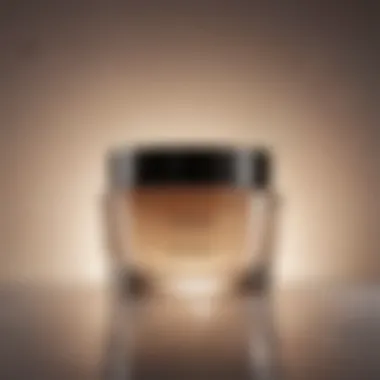Best Lotion for Bacne: Your Complete Guide to Relief


Intro
Bacne, or back acne, is a common skin condition that can significantly affect self-esteem and comfort. It often occurs due to various factors like hormonal changes, excessive oil production, and clogged pores. Understanding bacne is crucial for targeted treatment, making this guide a valuable resource.
This article aims to explore effective solutions for managing and preventing bacne. We will assess lotions suitable for various skin types while considering individual needs and preferences. The intersection of chemical and natural remedies will also be examined, providing a broad perspective on treatment options.
Tips and How-Tos
Dealing with bacne requires a well-structured skincare routine. Below are insights on how to approach skincare for different skin types to minimize bacne occurrences.
Skincare Routines for Different Skin Types
- Oily Skin:
- Dry Skin:
- Combination Skin:
- Use lightweight, non-comedogenic moisturizers.
- Look for ingredients like salicylic acid, which helps reduce oil and clear pores.
- Opt for hydrating lotions that retain moisture.
- Ingredients like glycerin and hyaluronic acid can be beneficial.
- Balance is key; seek products that address oiliness while hydrating dryness.
- Gel-based lotions are often effective for this skin type.
Haircare and Styling Basics
Often overlooked, haircare can also impact bacne. Here are some tips to consider:
- Avoid Heavy Products:
Heavy hair products can clog pores on the back and contribute to bacne. Look for lighter alternatives. - Regular Washing:
Keep hair clean and free from oils, especially before workouts or when wearing tight tops. - Loose Hairstyles:
Consider loose styles to avoid friction and irritation on the back area.
Sustainable Practices
Sustainability plays an important role in beauty. Eco-friendly products can often be gentler on the skin and the environment. Consider brands that prioritize natural ingredients and sustainable practices.
Eco-Friendly Fashion Brands
Many fashion brands now focus on eco-friendliness. Look for options that align with your values to preserve the planet while maintaining great style.
Tips for Sustainable Grooming
- Opt for products with minimal packaging.
- Choose natural ingredients to limit chemical exposure.
- Recycle or repurpose containers where possible.
Celebrating Diversity in Beauty
Beauty is not one-size-fits-all, and recognizing diversity is essential.
Inclusive Beauty Brands
Some brands cater to a wide range of skin tones and types. Research options that accommodate specific needs, including those prone to bacne.
Cultural Influences on Fashion
Cultural practices influence beauty standards and products. Embrace diverse perspectives to enrich your skincare journey and find what works best for you.
Understanding Bacne
Understanding bacne is essential for anyone dealing with back acne. This knowledge empowers individuals to recognize the challenges they face, leading to effective management strategies. Bacne can influence self-esteem, particularly for those who are often exposed to their backs. By understanding the condition thoroughly, a person can make informed choices about potential remedies and preventive measures.
What is Bacne?
Bacne refers to acne that appears on the back. It shares similar characteristics with facial acne. The primary difference lies in its location. Bacne can present as pimples, blackheads, or cystic lesions. It can occur at any age, but is common during teenage years and young adulthood. Knowing about bacne helps in identifying effective products designed specifically to treat it.
Causes of Bacne
Bacne has various causes, and recognizing these can guide treatment efforts. Common factors include:
Hormonal Changes
Hormonal changes can trigger bacne outbreaks. Fluctuations due to puberty, menstrual cycles, or hormonal birth control are notable contributors. These changes increase oil production in the skin. This makes hormones a critical factor for anyone struggling with bacne. Understanding hormonal influences can lead to targeted treatment approaches.
Clogged Pores
Clogged pores result from dead skin cells, oil, and bacteria accumulation. This blockage can lead to inflammation and acne. This aspect is significant for bacne because the back has more oil glands than other areas. Regularly exfoliating the back can help keep pores clear and reduce bacne occurrences, highlighting the importance of effective cleansing routines.
Excess Oil Production
Excess oil production is another significant factor. The skin naturally produces oil, but some people produce more than usual. This excess sebum can create an environment conducive to acne formation. Various factors, such as climate and diet, can influence oil production. Managing oil levels through specific skin care products can be an effective strategy for reducing bacne.
Genetics


Genetics play a vital role in determining one's susceptibility to bacne. If a person's family members have a history of acne, they may be more susceptible. This inherited tendency can influence the development of bacne throughout life. Recognizing genetic predisposition can help individuals to approach treatment with realistic expectations.
Symptoms of Bacne
Symptoms of bacne can differ from person to person. Common signs include:
- Redness and inflammation
- Painful cysts
- Pustules and blackheads
- Itching or tenderness
Recognizing these symptoms is crucial for managing bacne effectively. Identifying these signs early ensures timely intervention.
The Importance of Choosing the Right Lotion
Choosing the right lotion is crucial for anyone struggling with bacne. This skin condition can cause significant discomfort and embarrassment. Therefore, selecting a lotion that effectively targets the specific characteristics of bacne can lead to noticeable improvements. The right product can reduce outbreaks, soothe irritated skin, and promote healing. Moreover, understanding how various ingredients work can help individuals tailor their acne management approach to their unique skin needs.
Skin Type Considerations
An important aspect to consider when selecting a lotion is skin type. Different skin types—oily, dry, combination, or sensitive—require different ingredients and formulations. For instance, oily skin may benefit from lightweight lotions that control excess oil without clogging pores, while dry skin may need richer moisturizers that hydrate without exacerbating acne.
Ingredient Effectiveness
Salicylic Acid
Salicylic acid is a beta hydroxy acid known for its ability to penetrate pores and exfoliate from within. This characteristic helps to effectively unclog pores and prevent future breakouts. Its anti-inflammatory properties also make it a favorable choice for bacne sufferers. While it is widely considered beneficial, individuals with very sensitive skin may find it too harsh. Hence, patch testing is recommended.
Benzoyl Peroxide
Benzoyl peroxide is another go-to ingredient in acne treatment. It works by killing acne-causing bacteria and reducing inflammation. One key advantage of benzoyl peroxide is its fast action and effectiveness against existing breakouts. However, it can be drying and may cause irritation, especially for sensitive skin types. Therefore, it’s critical to use it in moderation and combine it with a suitable moisturizer after application.
Tea Tree Oil
Tea tree oil is a natural remedy with potent antibacterial properties. It is favored for its anti-inflammatory effects and its ability to calm redness and irritation associated with bacne. Its unique feature is that it may not be as harsh as chemical alternatives. However, some people may experience allergic reactions, so it’s advisable to do a patch test first.
Alpha Hydroxy Acids
Alpha hydroxy acids, such as glycolic acid, help exfoliate the surface of the skin and improve overall texture. They promote cell turnover and can effectively fade acne marks. The main benefit of alpha hydroxy acids is their ability to keep pores clear and reduce the appearance of dark spots. On the downside, they can increase sun sensitivity, so sun protection is essential during use.
Avoiding Irritating Ingredients
Selecting lotions means also being aware of potentially irritating ingredients.
Alcohol
Alcohol is commonly used in many skincare products but can be very drying. Its presence may lead to a stripped feeling on the skin, which could cause more oil production as a response. While it helps products to dry quickly, it can exacerbate existing dryness and irritation in sensitive skin. Avoiding alcohol can help to maintain skin’s moisture balance.
Fragrance
Fragrance is often added to lotions for scent. However, it can be a major irritant for many individuals. The presence of fragrance may lead to allergic reactions or irritation, making it a poor choice for sensitive skin types. Choosing fragrance-free options is advisable for those experiencing bacne.
Harsh Scrubs
Many exfoliators contain abrasive particles that disrupt the skin barrier. Harsh scrubs may cause micro-tears in the skin, leading to increased irritation and worsened bacne. Instead of harsh physical exfoliants, gentle chemical exfoliants are recommended to effectively clean without causing damage.
Top Lotions for Bacne
Selecting the correct lotion for bacne is crucial for effective treatment and prevention. It is necessary to understand both clinical and natural options available. The right product can not only alleviate symptoms but also prevent future breakouts. Moreover, considering individual skin types and concerns will assist in making well-informed decisions. With the variety of lotions on the market, it is vital to know which ingredients and formulations will provide the best results for managing bacne.
Clinical Options
Clinical options for bacne include prescription treatments and over-the-counter products. Both have their unique contributions to battling this skin condition.
Prescription Treatments
Prescription treatments are powerful solutions designed by dermatologists for severe cases of bacne. They often contain higher concentrations of active ingredients to target stubborn acne directly. A key characteristic is their tailored formulation for individuals who have not found relief with standard products. Common examples include topical retinoids and antibiotics.
While these treatments can be very effective, they might come with side effects such as dryness or irritation. They are, however, beneficial for persistent cases when used under professional guidance.
Over-the-Counter Products
Over-the-counter products provide an accessible avenue for managing bacne without prescriptions. These lotions typically contain active ingredients like salicylic acid or benzoyl peroxide. The appeal of over-the-counter products is their ease of access and suitability for milder cases.
Unique features of these products include a wide range of options geared towards specific skin types. They can be a cost-effective choice, though results may take longer. Additionally, users must be cautious of possible irritation, especially in sensitive skin types.
Natural Remedies
Natural remedies offer an alternative path for those seeking gentler solutions for bacne. These options often have fewer chemicals, appealing to users preferring holistic methods.
Aloe Vera


Aloe Vera is known for its soothing properties. This ingredient has anti-inflammatory and antimicrobial effects, which may help reduce redness and irritation associated with bacne. Its gel form can be easily applied directly to affected areas.
A prominent characteristic of Aloe Vera is its ability to hydrate the skin without adding excess oil. However, while it can be effective for mild cases, severe bacne may require more potent treatments.
Coconut Oil
Coconut oil is another natural remedy that is praised for its moisturizing qualities. It contains medium-chain fatty acids that help to combat bacteria. The key appeal of coconut oil is its multi-functional use, as it can also function as a moisturizer.
However, for very oily skin types, coconut oil may lead to clogged pores. Therefore, users need to assess their skin's response carefully.
Apple Cider Vinegar
Apple cider vinegar has gained popularity for its potential antibacterial and exfoliating properties. Many people use it as a toner or diluted in water as a topical treatment. A striking characteristic is its acid content that can help create an environment less favorable for acne bacteria.
Though effective for some, its strong acidity may irritate sensitive skin. Users should consider patch testing before widespread application.
Product Recommendations
Certain lotions have proven particularly effective in helping manage bacne. These products often contain well-researched active ingredients known for their efficacy.
Lotions with Salicylic Acid
Lotions containing salicylic acid are highly regarded for their ability to penetrate pores and reduce blockages. This ingredient helps to exfoliate dead skin cells and combat inflammation. Its effectiveness is a major reason for choosing these products in bacne care.
A potential disadvantage is its tendency to dry out the skin, so proper hydration after application is necessary.
Lotions with Benzoyl Peroxide
Lotions featuring benzoyl peroxide are also popular, known for their strong antibacterial properties. They kill the acne-causing bacteria and can effectively reduce redness and puffiness. The fast-acting nature of these products makes them a preferred option for many.
However, skin irritation and peeling can occur with benzoyl peroxide, so caution with usage is advised.
Lotions with Tea Tree Oil
Lotions with tea tree oil offer a natural antibacterial solution. Its unique feature lies in its capacity to soothe irritated skin while fighting acne. Users frequently appreciate its simple ingredient list, appealing to those with sensitive skin.
Nonetheless, effectiveness may vary among users, and some may experience allergic reactions. Testing on a small skin area is wise before regular usage.
Application Tips for Lotion
Applying lotion effectively is crucial for managing bacne efficiently. The way a product is applied can significantly affect its efficacy. Each step matters, from applying the lotion to the frequency of use. Developing a consistent routine can help in achieving optimal results. It is also essential to tailor these practices to individual skin types and needs. Here, we delve into several key factors surrounding lotion application, bringing clarity to each aspect.
Frequency of Use
Determining how often to use lotion is an important consideration. It can vary based on the product and skin tolerance. Most treatments might recommend usage once or twice daily. However, it is crucial to monitor how your skin reacts. Overuse of potent ingredients can lead to irritation rather than improvement.
Layering Products
Layering products is a method used to enhance the effectiveness of skincare routines. This section will explore the order and combinations that are best suited for bacne treatment.
Order of Application
The order of application is pivotal to maximizing the effect of lotions. Begin with the lightest products before applying heavier creams. For instance, a lotion with salicylic acid should be applied first, followed by a moisturizer. This method ensures that active ingredients penetrate deeply. Choosing the right order often leads to better overall skin health and faster results.
Complementary Products
Complementary products can enhance the performance of bacne treatments. Using a gentle cleanser before applying lotion can help remove impurities. Likewise, a non-comedogenic moisturizer will not block pores. Incorporating such products provides added benefits and supports the skin barrier. However, care should be taken as combining certain ingredients can lead to irritation.
Avoiding Common Mistakes
To achieve satisfactory results, avoiding common mistakes during application is essential. Missteps can hinder progress, causing unnecessary setbacks. Here are some common pitfalls to be aware of.
Using Too Much Product
Using too much product can lead to clogged pores instead of clearing them. A dime-sized amount is usually sufficient. Applying in excess can overwhelm the skin and cause reactions. Finding the right balance is key in ensuring effective treatment without harming the skin.
Skipping Patch Testing
Skipping patch testing can result in adverse reactions. It's best to apply a small amount of lotion on a discreet area first. This will enable you to gauge how your skin responds. Ignoring this step can lead to discomfort and unwanted breakouts. Using patch testing adds a level of precaution that is often overlooked.
Not Being Consistent
Not being consistent with application can significantly affect treatment outcomes. Like many skincare regimens, patience is required. Skipping days can interrupt progress, delaying results. Consistently following the recommended routine allows the skin to adjust and heal properly. It's beneficial to establish a routine that fits seamlessly into your daily life.
"Consistency is key to achieving visible results in skincare routines."


Lifestyle Adjustments for Bacne Prevention
Making lifestyle adjustments can be a significant part of managing bacne. This guide will explore how changes in diet, hydration, sweat management, and clothing choices can prevent bacne from becoming a persistent issue. By understanding these factors, you can better support your skin's overall health.
Diet and Hydration
What you consume can impact your skin. A balanced diet rich in vitamins, minerals, and antioxidants can improve your skin condition. Foods loaded with sugar and refined carbohydrates can increase inflammation and the risk of bacne. Make sure to include plenty of fruits and vegetables, whole grains, and lean proteins in your meals.
Staying well-hydrated is also crucial. Water helps in the detoxification process of the body and keeps your skin hydrated. Aim for at least eight glasses of water a day. By adjusting your diet and maintaining proper hydration, you support the body's ability to manage excess oil and bacteria, which are contributors to bacne.
Sweat Management
Sweating can both help and hinder your skin's health. While it helps to regulate temperature and flush out toxins, sweat can lead to clogged pores if not managed properly. Regular cleansing after workouts or periods of sweating is essential. Use a gentle, non-comedogenic cleanser to remove sweat, dirt, and oil without stripping your skin of necessary moisture. Consider using wipes for on-the-go cleansing too.
Clothing Choices
Fabric Types
The fabric of your clothing can significantly influence bacne. Natural fibers such as cotton allow the skin to breathe and reduce chances of skin irritation. In contrast, synthetic fabrics can trap heat and moisture, leading to breakouts. Lightweight and loose-fitting garments are preferred to allow air circulation, reducing sweat accumulation on the skin.
Choosing the right fabric is beneficial for those prone to bacne. For instance, breathable fabrics like linen and bamboo are ideal as they help in moisture control. Few people consider the impact of fabric, yet it can make a notable difference in skin health.
Fit and Comfort
How clothing fits can also affect bacne prevention. Tight clothes can rub against the skin, causing irritation and breakouts. Loose-fitting apparel helps prevent friction that can exacerbate acne. Fabrics that are soft and comfortable will contribute to overall skin health.
A key consideration is to choose garments that fit well but do not constrict. Comfort in clothing can lead to fewer skin irritations, ultimately promoting better skin health. Regularly assess your wardrobe to ensure it supports your skin care needs.
Staying mindful of clothing choices can lead to a noticeable improvement in bacne management.
By implementing these lifestyle adjustments, you equip yourself with tools to prevent bacne actively.
When to Seek Professional Help
Addressing bacne can sometimes require more than over-the-counter lotions and home remedies. Recognizing when to consult a professional is vital for effective treatment. Over time, bacne can escalate from mild irritation to severe skin issues that might necessitate dermatological intervention. Seeking professional help ensures that you receive tailored solutions for your skin type and specific condition, which is essential for long-term care.
Furthermore, professionals can provide insights that often remain overlooked. They not only offer access to potent treatments but also share knowledge about underlying conditions contributing to bacne. If left unaddressed, these conditions can result in scarring, emotional distress, or deterioration of skin health.
Signs of Severe Bacne
There are several indicators that suggest bacne has reached a level requiring professional assistance. For instance, if the bacne persists despite consistent use of topical treatments, it may signify a more serious concern. Other signs include:
- Presence of large cysts or nodules: These can be painful and might indicate a severe form of acne.
- Increased redness and swelling: This suggests an inflammatory response that may need medical evaluation.
- Frequent breakouts with scarring: Scarring can be psychologically distressing and often requires specialized care to treat effectively.
- Changes in skin texture: Any alteration can indicate underlying issues that require professional advice.
Recognizing these symptoms early aids in timely treatment, potentially preventing further complications.
Types of Specialists to Consider
When deciding to seek help for bacne, there are two primary types of specialists that can provide assistance: dermatologists and aestheticians.
Dermatologists
Dermatologists play a crucial role in managing bacne particularly when the condition is severe. They are medical doctors trained specifically in skin disorders. Their key characteristic lies in their ability to prescribe medications that are not available over-the-counter. This can include stronger topical treatments and even oral medications such as antibiotics or hormonal therapies.
The unique feature of dermatologists is their comprehensive knowledge of skin physiology and how various conditions interact. They conduct thorough skin assessments and, if necessary, recommend treatments that can lead to more immediate and effective results. For those struggling with severe bacne, a dermatologist is often the preferred and most beneficial choice due to their ability to provide a detailed diagnostic approach.
Aesthetician Services
Aesthetician services focus more on skin care treatments. Aestheticians often provide valuable insights and treatments, such as chemical peels and specialized facials that can help with bacne management. The primary advantage of aesthetician services is their emphasis on holistic skincare approaches tailored to individual needs. They can introduce supportive treatments that complement medical care.
However, it’s important to note that aestheticians do not have the medical training to diagnose or treat severe disorders. Thus, their care is generally more preventive and supportive rather than curative. For individuals with persistent or severe bacne, while aesthetician services can aid in the overall management of skin health, they should not replace medical consultations with dermatologists when necessary.
Seeking help from the right professional can lead to more effective treatment and a better understanding of your skin's needs.
Finale
The conclusion serves as an essential element of this article, consolidating the extensive information discussed regarding bacne and its treatment. Understanding bacne is critical, as it affects many individuals, impacting self-esteem and overall skin health. Thus, a thorough comprehension of its causes—like hormonal changes and excess oil production—alongside effective treatment options, is vital.
Summary of Key Points
In summary, several key points have emerged throughout this guide.
- Understanding Bacne: Many factors contribute to bacne, including genetics and environmental influences. Recognizing personal triggers helps in managing the condition.
- Choosing the Right Lotion: Each skin type has unique needs. Selecting appropriate ingredients, such as salicylic acid or tea tree oil, enhances the effectiveness of treatment.
- Application Tips: Proper application techniques are important. Avoiding common mistakes like using an excessive amount of product can lead to better results.
- Lifestyle Adjustments: Diet, clothing choices, and sweat management also play critical roles in preventing bacne.
- Professional Help: Knowing when to seek professional advice is significant. Experts like dermatologists can offer targeted solutions for severe cases.
Encouragement for Ongoing Care
Continuous care is key to maintaining healthy skin. It is crucial to integrate a consistent skincare routine that evolves alongside one's skin needs. Regular assessments of product effectiveness and adjustments based on changing conditions can lead to long-term success.
Moreover, patience is essential. Results might take time, but with dedication and the right approach, positive changes can be observed. Prioritize skin health not only for beauty but for personal well-being. Empower yourself with knowledge and commit to ongoing care, ensuring your skin remains in its best possible condition.
"Investing in your skin is a long-term commitment; consistency is your best option for achieving results."
Embrace this journey, stay informed, and adapt as necessary.







